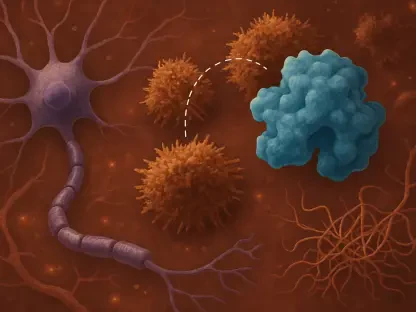Spermidine, a naturally occurring polyamine, has attracted significant attention in scientific research for its potential role in combating diabetes and the vascular complications that arise from this condition. A recent study published in Nature Cell Biology delves into how spermidine influences receptor-interacting serine/threonine-protein kinase 1 (RIPK1), offering groundbreaking insights into new treatments for diabetes. This research could pave the way for innovative therapeutic strategies aimed at reducing inflammation and metabolic damage, providing hope for millions of people suffering from diabetes and its associated vascular issues.
The Role of Spermidine in Cellular Health
Spermidine is widely recognized for its remarkable ability to induce autophagy, a cellular process that breaks down and removes damaged cellular components. This functionality helps reduce inflammation and regulate lipid metabolism, contributing to prolonged cellular health and lifespan. As a celebrated longevity agent, spermidine plays a vital role in maintaining metabolic balance and preventing age-related diseases. The study underscores the importance of spermidine’s actions on cellular processes, which are crucial in maintaining overall metabolic health.
One of the key findings of the research is how spermidine levels naturally decrease with age, leading to a host of metabolic dysfunctions, including diabetes. Supplementation of spermidine has emerged as a potential solution to counteract these declines, suggesting that maintaining adequate levels of this polyamine could improve metabolic health and help combat diabetes. This discovery emphasizes the importance of exploring spermidine as a means to mitigate age-related metabolic issues, including the prevention and treatment of diabetes.
Mechanisms of NAT and Spermidine
The research delves into the intricate role of N-acetyltransferase (NAT)-mediated post-translational modification, particularly highlighting acetylhypusination, in regulating insulin sensitivity and necroptosis. Human NAT2 (hNAT2) and murine Nat1 (mNAT1) are pivotal in this process, as they mediate insulin sensitivity through the acetylation of endogenous polyamines like spermidine and putrescine. NATs are essential for xenobiotic metabolism, thus carrying significant implications for metabolic health.
In the study, researchers compared Nat1 knockout (KO) and wildtype (WT) mouse embryonic fibroblasts (MEFs) to pinpoint differences in polyamine levels and their acetylated forms. The findings emphasized the crucial role of spermidine in regulating necroptosis—a form of programmed cell death—and RIPK1 activation. This comparison sheds light on the specific mechanisms through which spermidine influences these cellular processes, making it a key player in maintaining metabolic equilibrium.
Diabetes and Metabolic Damage
Type 2 diabetes (T2D) is a chronic condition affecting over 537 million adults worldwide, and current management strategies primarily focus on hyperglycemia. This condition is notoriously associated with progressive damage to tissues and organs, including the heart, kidneys, and eyes. However, the underlying mechanisms driving the onset and progression of T2D remain poorly understood, necessitating further exploration.
The study aims to bridge this gap by illuminating how spermidine influences metabolic processes and inflammation. Understanding these intricate interactions is crucial for developing innovative treatments that target the fundamental causes of diabetes and its myriad complications. By delving deeper into how these processes unfold, researchers hope to find more effective solutions to address the root causes of T2D, rather than just managing its symptoms.
Spermidine’s Impact on RIPK1 and Inflammation
Through mass spectrometry, the research identified a staggering 1,895 proteins modified by spermidine, with RIPK1 and eIF5A being particularly noteworthy. This discovery unveiled a novel role for acetylhypusination in modulating RIPK1’s activity, providing new insights into how spermidine can influence inflammation and metabolic damage. These findings suggest that acetylhypusination could be a target for therapeutic intervention, potentially offering a way to regulate RIPK1 and its downstream effects.
Conditional knockout models provided further evidence showing how spermidine levels correlate with insulin resistance and obesity—factors significantly mediated by RIPK1. In Nat1-deleted mice, the reduction of spermidine led to insulin resistance and adipocyte hypertrophy, conditions that were notably suppressed when RIPK1 was inactivated. This reinforces the idea that spermidine plays a critical role in regulating these metabolic pathways, highlighting RIPK1 as a potential target for therapeutic strategies.
Vascular Integrity and Inflammation
Further examination of the study revealed that endothelial cell-specific Nat1 deletion leads to disrupted vascular integrity and subsequent inflammation, a pathology that was markedly mitigated by RIPK1 inhibition. This suggests that targeting RIPK1 could be a viable strategy for preserving vascular health, particularly in diabetic patients who are prone to such complications. The ability to counteract these adverse effects by targeting specific molecular pathways offers a promising avenue for treatment.
The researchers also examined human vascular tissue, discovering that patients with Type 2 diabetes exhibited reduced spermidine levels and activated RIPK1. This connection emphasizes the pathological role of RIPK1 in diabetic complications and underscores the potential benefits of spermidine supplementation. By restoring spermidine levels, it may be possible to counteract the harmful activation of RIPK1 and, in turn, mitigate vascular damage associated with diabetes.
Therapeutic Potential of Spermidine
The principal findings of the study indicate that spermidine intervenes in the progression of diabetes by modifying RIPK1 through acetylhypusination. This modification helps regulate inflammation and various metabolic pathways, thereby offering promising therapeutic potential. Targeting RIPK1 could offer a new approach to managing vascular and metabolic complications in diabetes, presenting a novel strategy for enhancing patient outcomes.
By focusing on the groundbreaking discovery of how acetylhypusination modifies RIPK1, researchers have unlocked new possibilities for innovative treatments that target these particular pathways. This approach could significantly mitigate late-stage diabetic complications while improving overall metabolic health, providing a new lease on life for patients grappling with diabetes and its associated health problems.
Future Research and Implications
Spermidine is a naturally occurring polyamine that has garnered substantial attention in the scientific community for its potential role in fighting diabetes and its related vascular complications. A recent study featured in Nature Cell Biology explores how spermidine affects receptor-interacting serine/threonine-protein kinase 1 (RIPK1). This research unveils groundbreaking insights, opening the door for novel diabetes treatments. By focusing on the role of spermidine, scientists are hopeful that they can develop new therapeutic strategies to reduce inflammation and mitigate metabolic damage. This discovery holds promise for millions of people grappling with diabetes and its vascular complications, potentially revolutionizing how this chronic condition is managed. With ongoing research, the future could see innovative approaches to alleviate the burden of diabetes, offering a beacon of hope for improved quality of life for those affected by this widespread health issue.









